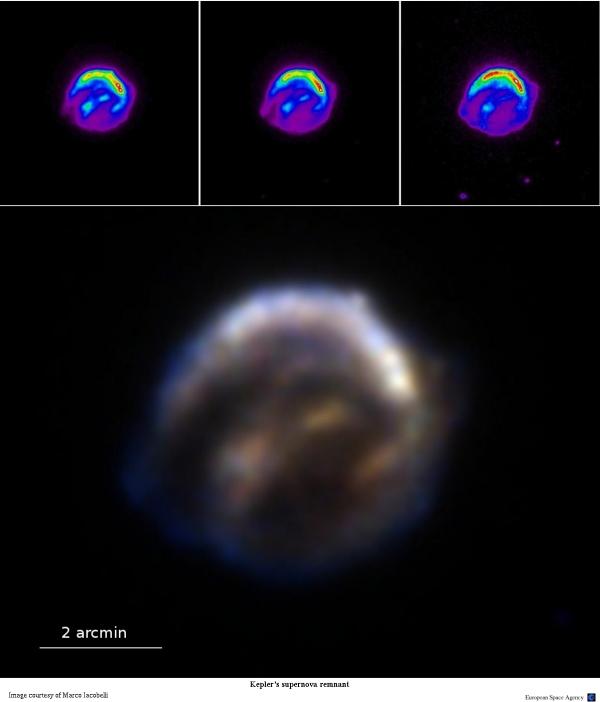
 Credit: Marco Iacobelli and ESA
Credit: Marco Iacobelli and ESA
405
On October 9, 1604, four hundred and five years ago, a new star was seen. This "new star" was actually the explosive death of an old star. Initially as bright as Mars, it was noticed in Europe by a number of people, in particular a sky-watcher in Prague named Jan Brunowski who saw it, and notified the relevant authority: Johannes Kepler. Bad weather kept Kepler from viewing the new star until October 17, but he kept up observing it for more than a year, until it faded below naked-eye visibility in March 1606. This "new star" was in fact a supernova, the last supernova to be observed in the Milky Way. Because of his dedication, the supernova was named in Kepler's honor. The image above is an X-ray image of Kepler's Supernova as observed by the XMM-Newton space observatory. The images on the top show (from left to right) X-ray images at soft, medium and hard X-ray energies and reveal how the shock wave from the explosion propagates into the surrounding medium. The larger image shows a faint blue rim (due to a forward shock), and a strongly asymmetric brightness distribution in X-rays, the remnant being brighter in the north and north west part. Astronomers now believe that Kepler's supernova was actually a Type Ia supernovae, the explosion of a white dwarf star. Type Ia supernovae are particularly important, since they serve as "standard candles" since their explosion energies (and hence maximum brightness) are almost all the same. Astronomers use these "standard candles" to measure distances in the Universe, and they have been used to show the existence of "dark energy".
Published: August 24, 2009
<
HEA Dictionary ● Archive
● Search HEAPOW
● Other Languages
● HEAPOW on Facebook
● Download all Images
● Education ● HEAD
>
Each week the HEASARC
brings you new, exciting and beautiful images from X-ray and Gamma ray
astronomy. Check back each week and be sure to check out the HEAPOW archive!
Page Author: Dr. Michael F. Corcoran
Last modified Monday, 26-Feb-2024 17:45:47 EST


